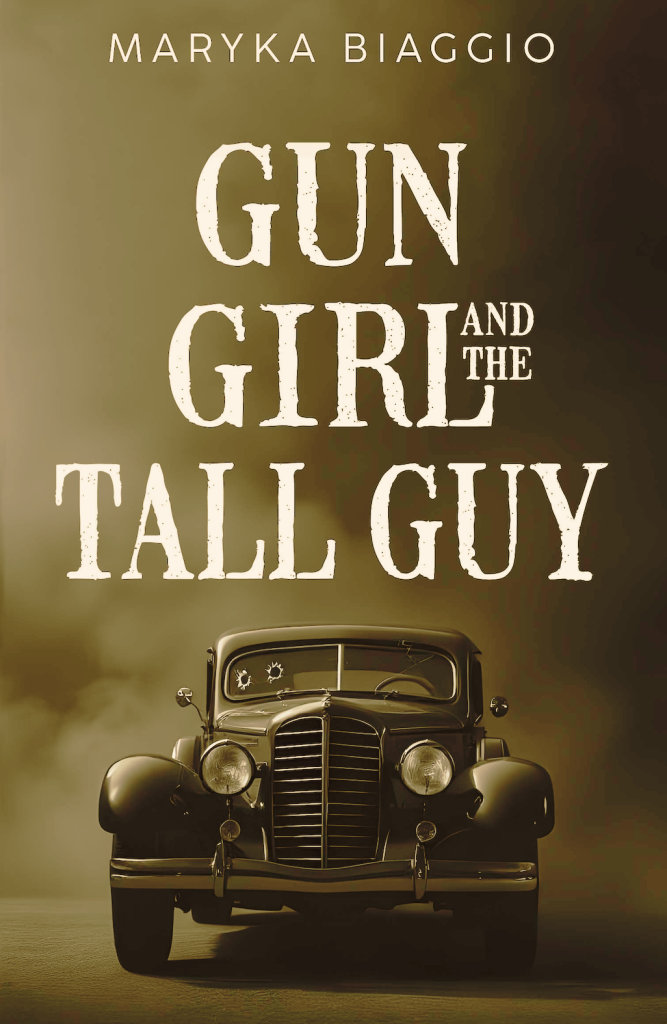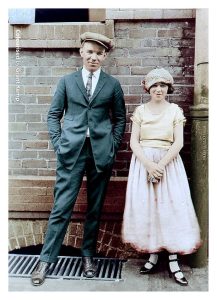
TO FIND THE E-BOOK go here.
FOR THE BEST PRICE ON THE PAPERBACK go to:
Bookshop.org (10% of sales go to indie bookstores)
or
Gun Girl and the Tall Guy
1924 Brooklyn—love, crime, and no turning back. Gun Girl and the Tall Guy tells the true story of Brooklynites Celia and Ed Cooney.
When newlyweds Celia and Ed Cooney discover Celia is pregnant, they pledge to give their baby a good life—but what’s a couple living in a cramped room on $30 a week to do? They start robbing Brooklyn businesses, much to the amusement of the city’s newspapers: A woman bandit is a true novelty in 1924 New York, especially a brazen, baby-faced woman toting a pistol. As the pair’s robberies become more audacious and the police bungle their attempts to nab them, the papers have a heyday with the police’s ineptitude. Increasingly humiliated, the police commissioner gives the order to shoot to kill. Will Ed and Celia elude the deadly dragnet of Brooklyn’s men in blue?
View the book trailer:
Praise for Gun Girl and the Tall Guy
“In Gun Girl and the Tall Guy, Maryka Biaggio delivers a gripping tale based on the true story of Celia and Ed Cooney, a Brooklyn couple who turned to crime in 1924. With vivid prose and rich historical detail, Biaggio captures a world where love, survival, and crime collide.”
—Elizabeth Mahon, author of Scandalous Women and Pretty Evil New York
“A well-researched, gutsy tale of a 1920s couple on a small-scale crime spree. With Biaggio’s deft prose and clever plotting, Gun Girl and the Tall Guy is a precursor to the tale of Bonnie and Clyde.”
—Tonya Mitchell, award-winning author of A Feigned Madness and The Arsenic Eater's Wife
“The romantic, riveting, mad-cap adventures of the Bob-Haired Bandit and her handsome man in 1920s Brooklyn will keep you turning pages late into the night. I gobbled it up and loved every minute of it!"
—Laurie Lico Albanese, author of Hester and Stolen Beauty
“Celia and Ed have the Roaring Twenties spark of Agatha Christie's Tommy and Tuppence Beresford—if they had taken a dark page out of Bonnie and Clyde's lawless book. Gun Girl and the Tall Guy will keep aficionados of true crime and fans of Prohibition Era thrillers turning the pages all night long."
—Mary Anna Evans, award-winning author of The Dark Library
If you enjoyed Gun Girl and the Tall Guy, check out my recommendations for Best Books About Puzzling True Crimes From History.
The Compelling World of True-Crime Fiction: Why We Can’t Look Away

Why are readers fascinated with crime stories? True-crime fiction has become a cultural phenomenon, captivating readers across generations with its unique blend of intrigue, psychological depth, and narrative tension. But what drives our seemingly insatiable appetite for stories that delve into the darker corners of human behavior?
At the heart of true crime's appeal is a complex psychological fascination. These stories offer readers a safe environment to explore the extremes of human nature. The thrill of the chase, the unfolding of clues, and the suspenseful twists keep readers engaged. Moreover, these narratives often present compelling moral puzzles. They challenge our understanding of good and evil, demonstrating that human behavior exists in nuanced shades of gray. By presenting thoroughly researched accounts of crimes, authors invite readers to suspend judgment and engage in deeper psychological analysis.
The intellectual challenge of understanding criminal behavior also plays a significant role in our attraction to these stories. Readers become amateur detectives, piecing together evidence, examining motivations, and attempting to comprehend the seemingly incomprehensible.
Finally, there’s the appeal of justice and resolution. Many historical crimes went unsolved or were shrouded in controversy. Fictionalized retellings allow authors to explore possible solutions, reimagine events, or even give victims a voice that history denied them.
Historical crime fiction reveals not just individual psychological profiles but also social contexts that shaped criminal behaviors. They provide insight into how past societies viewed crime, morality, and punishment. Readers might learn about the moral hypocrisies of the Victorian era, the corrupt law enforcement of the Gilded Age, or the violent underworld of Prohibition. These historical settings provide a deeper understanding of how societies functioned and how justice—or lack thereof—was meted out.
Ultimately, true-crime fiction is more than mere sensationalism. It's a profound exploration of human complexity, social dynamics, and the intricate mechanisms of justice and morality.